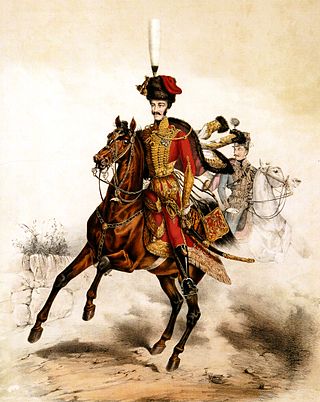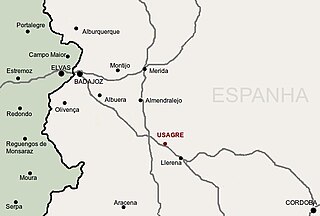Related Research Articles

Dragoons were originally a class of mounted infantry, who used horses for mobility, but dismounted to fight on foot. From the early 17th century onward, dragoons were increasingly also employed as conventional cavalry and trained for combat with swords and firearms from horseback. While their use goes back to the late 16th century, dragoon regiments were established in most European armies during the 17th and early 18th centuries; they provided greater mobility than regular infantry but were far less expensive than cavalry.

A hussar was a member of a class of light cavalry, originating in Central Europe during the 15th and 16th centuries. The title and distinctive dress of these horsemen were subsequently widely adopted by light cavalry regiments in European armies during the late 17th and 18th centuries. By the 19th century, hussars were wearing jackets decorated with braid plus shako or busby hats and had developed a romanticized image of being dashing and adventurous.

The Third Army was originally established in Skopje and later defended the northeastern provinces of the Ottoman Empire. Its initial headquarters was at Salonica, where it formed the core of the military forces that supported the Young Turk Revolution of 1908. Many of its officers who participated in the Revolution, including Enver Pasha and Mustafa Kemal Atatürk, rose to fame and power.

In the Battle of Usagre on 25 May 1811, Anglo-Allied cavalry commanded by Major-General William Lumley routed a French cavalry force led by Major-General Marie Victor Latour-Maubourg at the village of Usagre in the Peninsular War.
The 3rd Army Corps was an Army corps in the Imperial Russian Army formed on 19 February 1877.

In the Battle of Campo Maior, or Campo Mayor, on 25 March 1811, Brigadier General Robert Ballard Long with a force of Anglo-Portuguese cavalry, the advance-guard of the army commanded by William Beresford, clashed with a French force commanded by General of Division Marie Victor de Fay, marquis de Latour-Maubourg. Initially successful, some of the Allied horsemen indulged in a reckless pursuit of the French. An erroneous report was given that they had been captured wholesale. In consequence, Beresford halted his forces and the French were able to escape and recover a convoy of artillery pieces.
The I Corps of the Ottoman Empire was one of the corps of the Ottoman Army consisting of ethnic Albanians. It was formed in the early 20th century during Ottoman military reforms

The III Corps of the Ottoman Empire was one of the corps of the Ottoman Army. It was formed in the early 20th century during Ottoman military reforms.
The IV Corps of the Ottoman Empire was one of the corps of the Ottoman Army. It was formed in the early 20th century during Ottoman military reforms. It was disbanded at the end of World War I.
The V Corps of the Ottoman Empire was one of the corps of the Ottoman Army. It was formed in the early 20th century during Ottoman military reforms.
The VII Corps of the Ottoman Empire was one of the corps of the Ottoman Army. It was formed in the early 20th century during Ottoman military reforms.
The X Corps of the Ottoman Empire was one of the corps of the Ottoman Army. It was formed in the early 20th century during Ottoman military reforms.
The following is the order of battle of the Hellenic Army during the First Balkan War of 1912–1913.
The Vardar Army of the Ottoman Empire was one of the field armies under the command of the Western Army. It was formed during the mobilisation phase of the First Balkan War.
The Chataldja Army or Çatalca Army of the Ottoman Empire was one of the field armies of the Ottoman Army. It was formed after Ottoman retreat to the Chataldja line during the First Balkan War. It confronted Bulgarian forces. It was organized from units of dissolved First Eastern Army and Second Eastern Army on November 7, 1912.
The 2nd Guards Cavalry Division was a Guards light cavalry division of the Imperial Russian Army.
The 2nd Cavalry Division was a cavalry formation of the Russian Imperial Army.
The 7th Cavalry Division was a cavalry formation of the Russian Imperial Army.
Milivoje Čolak-Antić was a Royal Serbian Army officer, most notable for his command of Chetniks volunteer detachments in Macedonia during the Balkan Wars, and his actions with Operation Departments during World War I for which he received multiple awards.
References
- Schulz, Hugo (1992). Die preussischen Kavallerie-Regimenter 1913/1914 nach dem Gesetz vom 3. Juli 1913. Augsburg: Weltbild. pp. 174–175. ISBN 3893503439.